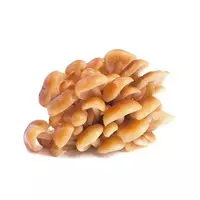Winter sheepskin

Winter hazelnuts (Flammulina velutipes) are classified as edible mushrooms that belong to the Ryadovka family of the Flammulin genus. Among other Russian names for this mushroom, such as Collibia velvety-legged, Flammulina velvety-legged and winter mushroom are also known.
In Western countries, cultivated mushrooms are called "enokitake" in Japanese, while the Russian trade network provides a selection of imported cultivated mushrooms called "inoki. "
Japan, Korea and a number of other countries cultivate this species of fungi on an industrial scale. As a substrate for winter openka, it is customary to use specially moistened wood or as an option to cut wheat straw. Interestingly, the harvest can be obtained practically during the round year, and the world production of winter sheepskin is up to 100, 000 tons per year.
The fruit body of the winter hazel is hatchet, although sometimes the central or weakly eccentric is found. At the same time, the shape of the hat in this mushroom, the diameter of which can vary within 2-10 centimeters, is usually convex in young mushrooms. Winter hazelnuts are yellow, honey brown or orange brown in color. Usually the edges of the mushroom hat are somewhat lighter than the middle.
The thin flesh of winter hazel can be colored in a white to light yellow hue. It has a rather pleasant taste, so this mushroom is widely used for culinary purposes. The tubular dense leg of the winter hazel has a characteristic velvety-brown color, while it is yellowish-brown on top.
As you know, winter hazel is considered a parasite or saprotrophe that grows on damaged or weakened deciduous trees. In addition, it can be found on dead wood, often on poplars and willows, on forest edges, along stream banks, in parks and gardens.
The winter hazel bears fruit in dense groups that form peculiar seams. This fungus is quite common in the northern temperate zone. The winter autumn season is considered to be the time from autumn to spring. Interestingly, it is able to continue to bear fruit during winter thaws, so it is often found under the snow.
Winter openok is an edible mushroom of the fourth category. As a rule, it is used fresh - it is boiled, pickled and salted. In young mushrooms, you need to cut off the dark part of the leg, and in old winter opats, only hats are prepared. A distinctive feature of this mushroom is that it remains slippery when cooked, and not all consumers like it. In addition, winter hazel perfectly tolerates frosts, while not losing its taste, thanks to which it can be collected both by ice cream and thawed.
winter openka 22 kKal
Energy value of winter sheepskin (Ratio of proteins, fats, carbohydrates - ju):
Proteins: 2.2 g (~ 9 kCal)
Fats: 1.2 g (~ 11 kCal)
Carbohydrates: 0.5 g (~ 2 kCal)
Energy ratio (bj | y): 40% | 49% | 9%
 Español
Español Français
Français Português
Português Русский
Русский 简体中文
简体中文 繁體中文
繁體中文 日本語
日本語 한국어
한국어 العربية
العربية Türkçe
Türkçe Қазақ
Қазақ Deutsch
Deutsch Italiano
Italiano Українська
Українська
